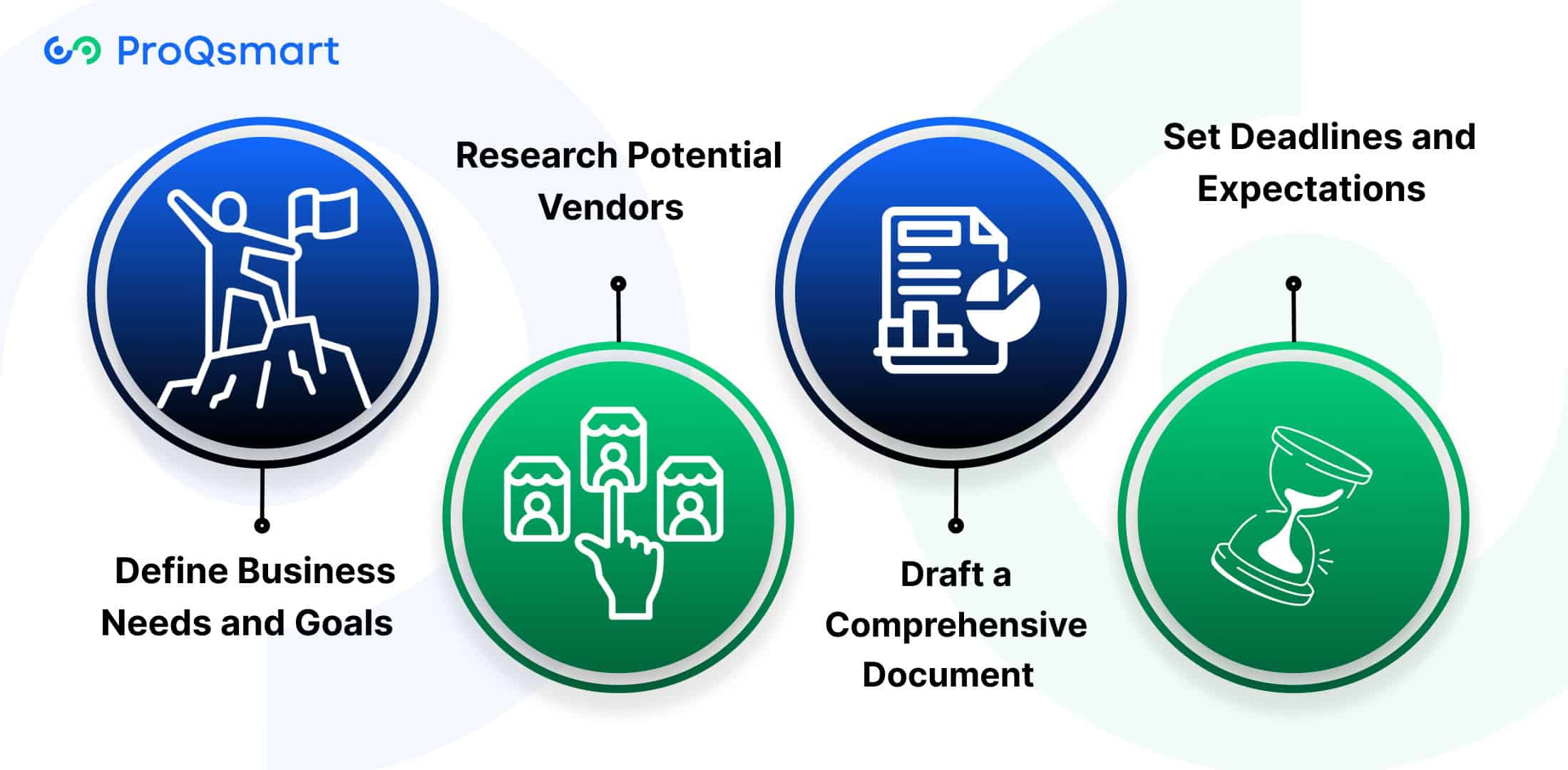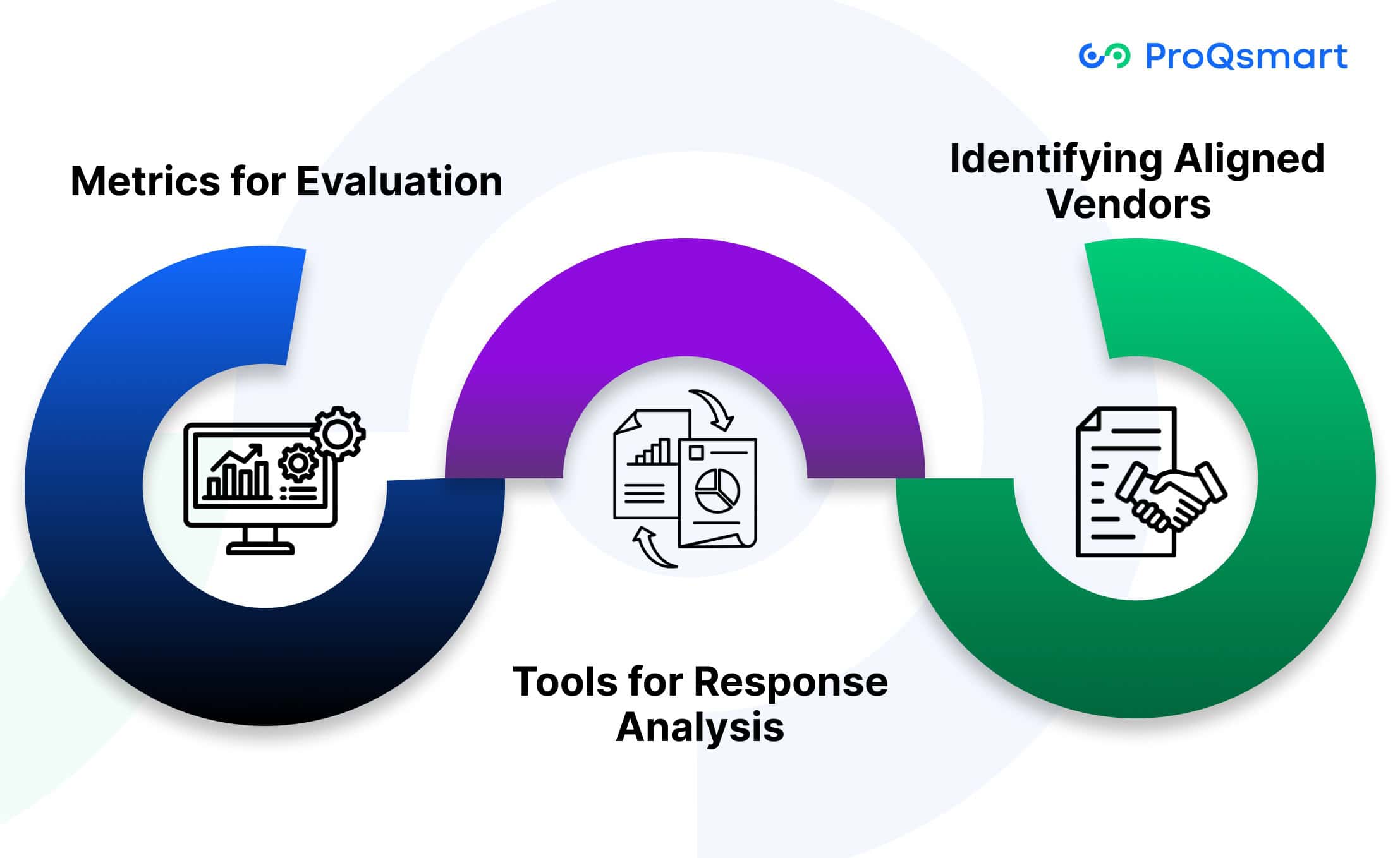An RFI, or Request for Information, is a common formal document used in procurement. It’s a great vetting tool to get in-depth information from prospective suppliers. It is a critical resource for gaining insight into supplier capabilities, product offerings, and service options prior to purchase.
When used correctly, RFI allows businesses to compare several vendors at once, saving time while finding a vendor that best meets the needs of the project and the company. This supplier selection process not only helps identify the best supplier but minimizes risk and prevents expensive errors.
RFIs are particularly beneficial in dynamic and complicated procurement environments. They are invaluable in providing consistent guidance when procuring highly specialized equipment or services.
When properly structured, RFIs can help organizations promote transparency, encourage competition, and lay strong foundational partnerships with future partners. It lays the groundwork for data-informed, strategic procurement decisions.
Importance of a Well-Defined RFI
A clear, well-defined RFI is critical to the procurement process. It delivers transparency, increases productivity, and keeps everyone on the same page across the entire sourcing process. By focusing on your unique needs and goals, it reduces risks and increases value.
Here are three key reasons that underscore the value of a well-defined RFI:
Avoid misaligned vendor choices through clear specifications.
Save time in the evaluation process with focused criteria.
Ensure strategic business alignment for effective sourcing.
Benefits of Using an RFI
There are a number of benefits to an RFI. It gives crucial information about what the market has to offer, allowing buyers to weed out the least appropriate vendors right from the start.
Procurement teams typically experience a stunning efficiency increase of 30% to 40%. They do this by sending RFIs to narrow the field before entering into detailed negotiations.
RFIs foster more competitive pricing and more vendor-prepared vendors — which all contributes to a much better negotiation outcome. By establishing a clearer set of business priorities from the start, RFIs reduce the time and effort required to select the right vendor and encourage better decision-making.
Key Elements of an RFI
When done thoughtfully, a well-prepared Request for Information (RFI) can facilitate informed and strategic decision-making in procurement. It allows organisations to request critical insights from qualified vendors and tailor their services to fit project requirements. By incorporating these key elements, an RFI sets the stage for clarity and efficiency throughout the entire sourcing process, ultimately leading to innovative solutions.
Clear Objectives and Scope
Setting clear goals and participation outcomes for an RFI is critical to inform the development of objectives. Clear objectives will help you determine what you’re trying to achieve, whether that’s finding qualified vendors or learning what the market is capable of.
Providing details on the goods or services needed allows vendors to get a complete picture of what is required. For instance, if a construction project requires sustainable materials, the RFI should detail the quantities, delivery timelines, and sustainability criteria.
Aligning the objectives with business goals will help keep the RFI focused and actionable. Reassessing objectives throughout the process is key to ensuring they’re accurate and relevant.
Structured Questions for Vendors
Developing clear, focused questions is key to getting back thoughtful proposals. Open-ended questions like, “Explain your approach to projects of this nature” allow flexibility for the respondent to give informative responses.
Organizing questions into categories such as technical capabilities, pricing, and security/compliance make it easier to compare and judge vendors against one another. For instance, inquiry into obstacles faced in previous projects can highlight a vendor’s abilities to overcome hurdles.
Bigger-picture review of questions on a regular basis keeps things aligned with the development goals of the project while avoiding over-complication.
Response Format and Guidelines
Setting guidelines for vendor responses makes it easier to compare vendor responses fairly and helps to maintain consistency. A standardized format, like requiring all RFIs to use the same template, makes evaluation easier.
As an example, ProQsmart helps procurement teams work faster and smarter with e-tenders and supplier performance monitoring to improve compliance and transparency. RFIs should include clear response deadlines, desired submission formats, and the level of detail expected.
Giving vendors at least one to two weeks allows for meaningful, in-depth responses.
Steps to Create an Effective RFI

Creating a clear and focused RFI is a critical initiative in ensuring a fair and efficient procurement process. This allows you to gather valuable insights from potential suppliers. Each step is essential to making sure the RFI process serves the organization’s needs, particularly in terms of safety and service solutions, to the fullest. Here are the vital steps in creating a great RFI in detail.
Define Business Needs and Goals
Start from a place of understanding your organization’s unique needs to set the direction for the RFI. Decide exactly what goods or services you need and connect these aims to larger corporate goals. For instance, a construction firm might focus on more sustainable materials if that directly aligns with their long-term corporate sustainability goals.
Including key stakeholders helps ensure you’re capturing different aspects of what’s needed while introducing varied perspectives. Focus first on the needs that are most pressing and have the most transformative potential. Be sure to keep the RFI geared on these essential details while maximizing clarity.
Research Potential Vendors
Thorough research into potential vendors is vital. Use market analysis to identify vendors whose offerings align with your needs. Evaluate their past performance, reputation, and reliability by examining case studies or client testimonials.
Compile a list of candidates using specific criteria, such as experience in your industry or certifications. For instance, ProQsmart’s supplier performance monitoring tools can streamline vendor evaluations by providing real-time insights into their contract compliance and reliability.
Draft a Comprehensive Document
Our RFI document really was the key to the whole process. Remove all ambiguity by including a clear, concise statement of need. Include detailed information, including background on your organization and requirements for your RFI on specific goods or services needed.
Use an RFI template or a tool such as ProQsmart’s e-tendering feature to maintain consistency and improve efficiency. Run spellcheck to avoid looking unprofessional, and save the document in a public facing, easily accessible and collaborative, cloud-based platform.
Set Deadlines and Expectations
Establish realistic deadlines for vendor responses and communicate these clearly. Define expectations for the quality and detail of submissions to avoid incomplete responses. Allocate time for vendors to ask clarifying questions, reducing misunderstandings.
Set internal timelines to evaluate responses promptly. Tools like ProQsmart’s automated workflows can streamline this process while ensuring compliance with organizational and regulatory standards.
Analyzing RFI Responses

Analyzing RFI responses is a critical step in procurement, particularly for organizations looking to implement effective life safety solutions. This process serves as the basis for strategic vendor selection, requiring a structured approach to ensure clarity and actionable insights.
Develop metrics for evaluation.
Utilize tools for response analysis.
Identify aligned vendors based on criteria.
Metrics for Evaluation
Clarifying the proper metrics upfront is essential to the evaluation of vendor responses. Start by defining detailed parameters like cost effectiveness, delivery schedules, sustainability efforts, technology use, etc.
Include quantitative measures such as delivery pricing and delivery success rates in your comparative analysis. Additionally, look at qualitative aspects like vendor experience and innovation.
Metrics should ultimately support your organization’s overall objectives, be that realizing cost savings, fostering better relationships with suppliers, or driving toward sustainability commitments. To make future evaluations better, reevaluate your selected metrics on a regular basis, using lessons learned from previous RFI processes to make them even more precise.
Tools for Response Analysis
Response analysis can be made easier with the right tools to help you organize, track, and compare responses. Spreadsheets are great for doing one-off comparisons between a few data points, but more sophisticated platforms, such as ProQsmart, provide other advantages.
ProQsmart’s AI-driven features streamline processes by automating rigorous evaluation workflows and delivering invaluable analytics to radically improve efficiency. Features like suppliers performance tracking and budgets tracking make it easier to analyze responses while maintaining compliance.
For especially complex RFIs, look to analytics platforms to get a more holistic perspective on vendor capabilities and overall alignment.
Identifying Aligned Vendors
Identifying qualified vendors that can best address your business requirements takes a systematic process. To begin, compare each response against your benchmarks, looking first for alignment with your strategic goals such as reducing costs or increasing innovation.
Flag vendors showing superior compatibility, and use tools such as ProQsmart to build a shortlist based on fact and data. Functions like subcontractor oversight and performance reviews on your suppliers can help you find vendors most able to move your organization’s goals forward.
Using RFIs for Collaboration

An RFI is not just a data-gathering exercise. More importantly, it requires and encourages collaboration between procurement teams and their vendors. When organizations make relationship building a priority in their RFIs, they open the door to more transparent communication.
This strategy fosters collaborative, trust-based partnerships and raises the quality of the procurement process for all parties.
Building Vendor Relationships
Strong vendor relationships start with early engagement. Engaging vendors early in the procurement process helps ensure that their capabilities are aligned with your needs. This saves time and helps align both parties to the same vision.
Being in constant communication helps to create this unique connection even more, establishing trust and rapport over time. For instance, setting up regular check-ins or informal status updates while the RFI is in action helps ensure both parties are on the same page.
Welcoming vendors to provide their insights after an RFI process strengthens future efforts. It communicates to them that we are genuinely interested in their input. Whatever form it takes, recognizing their contributions further builds the collaborative relationship and can be as easy as a simple shout-out or a written letter of appreciation.
Encouraging Transparent Communication
Having clear communication channels can be key to fostering a collaborative environment. Having clear points of contact helps ensure that available vendors know exactly where to direct their questions.
Being proactive with communication at each step of the RFI process helps to keep vendors informed and engaged. For example, informing vendors when your timeline changes or being open and clear about your expectations builds goodwill and trust.
Encouraging vendors to raise their red flags promotes transparency, and building an open and trusting culture is what really drives collaboration.
Promoting Long-Term Partnerships
Collaboration flourishes when relationships go past one-off deals. Finding opportunities for joint ventures or continued work deepens connections.
For instance, jointly developing solutions to common procurement challenges can be mutually advantageous. Creating frameworks for regular and reliable communication, like quarterly check-in meetings, builds the foundation for this support.
By viewing vendors as strategic partners instead of just vendors, it creates a mutual understanding of objectives and gives both parties a unified focus on achieving success.
Leveraging Insights from RFIs
RFIs are not just valuable data points, but rather, they provide a bedrock for more intelligent and streamlined procurement strategies. Through systematic analysis of these insights, procurement professionals can make informed decisions, improve processes, and better support their organizational goals.
Here are some targeted strategies to ensure you’re getting the most bang for your RFI buck:
Inform strategic sourcing decisions based on RFI insights.
Improve procurement processes through lessons learned.
Enhance vendor selection criteria using gathered data.
Informing Strategic Sourcing Decisions
The information shared in RFIs leaves a treasure trove of insights that can inform and even optimize sourcing strategies. Responses help illuminate market trends, vendor capabilities, and innovative solutions that are not otherwise on our radar.
For instance, vendor feedback might bring to light some promising new technologies that further sustainability objectives or compliance with next-gen regulatory requirements. Then, businesses can apply this understanding to their sourcing decisions to make sure they’re meeting their immediate needs while working toward broader goals.
RFIs provide an excellent tool for organizations to evaluate what vendors are offering in the marketplace. When a vendor shares outstanding knowledge in how to find savings on capital expenditure projects, remember their tips.
These are very valuable perspectives that can make a big difference in your selection process. ProQsmart, with its AI-driven analytics, takes it a step further, streamlining the process by consolidating market intelligence and automating bid comparisons for more strategic sourcing.
Improving Procurement Processes
Unfortunately, the RFI process is often used to further obfuscate procurement workflows. By standardizing templates for RFIs, it guarantees that all responses are consistent in format, minimizing time dedicated to analyzing responses.
In fact, 80% of organizations still use RFIs to filter through potential vendors. This practice is very valuable to their ability to narrow down and streamline their procurement decisions. The biggest lessons you can learn though come from the RFIs that succeed.
Feedback may indicate you should find ways to accelerate your subcontractor pre-qualification process. With ProQsmart’s subcontractor management tools, you can get ahead of this risk.
Enhancing Vendor Selection Criteria
Vendor selection criteria should be flexible to adapt to organizational needs. RFI insights allow procurement teams to define these criteria more comprehensively.
For instance, many times responses emphasize qualitative qualities such as innovation or reliability, which can then be included in a selection metric. ProQsmart backs this refinement with rigorous supplier performance monitoring, providing real-time market intelligence to help identify vendors who are quick, reliable, and cost-effective.
Bringing stakeholders along in this process makes this priority-setting process inclusive and relevant. For example, working with compliance teams throughout RFI analysis can help you spot vendors who are already skillful at achieving new industry standards.
By taking this holistic view, ingredient intelligence goes beyond driving compliance to build stronger supplier relationships in the long run.
Tips for Vendors Responding to RFIs
It gives them the opportunity to lay the groundwork for a fruitful relationship with soon-to-be clients. A well-thought-out response to an RFI demonstrates the depth of your knowledge and significantly contributes to establishing your company as a trusted partner. Here are some practical insights to help vendors succeed in their RFI responses.
Understand Client Needs Thoroughly
Prior to putting pen to paper on your response, take a moment to thoroughly research the organization sending out the RFI. Dig into their specific industry, their current challenges, and strategic goals to craft answers that speak directly to their needs.
If some part of the RFI is confusing, ask for clarification so you don’t mistakenly get it wrong. If you respond to an RFI from a construction firm, structure your response to highlight your innovative solutions that focus on sustainable building materials.
This approach will appeal to them much more powerfully. Try to think of the questions they would ask you if following up, and address those questions directly in your response to them. This level of preparation shows not just your dedication, but your creativity in thinking ahead to what they’ll be prioritizing.
Provide Clear and Concise Answers
Clarity is the most important aspect of your response. Provide clear and concise responses, avoiding excessive jargon or technical language. Organize your response in a natural flow that makes it easy for the evaluators to read and understand.
Use bullet lists or bold text to highlight important points to help them stand out. When you talk about procurement tools, such as ProQsmart, make sure to emphasize its AI-driven decision-making capabilities.
Focus on how it helps achieve budget objectives to best highlight the platform’s functionality.
Highlight Unique Value Propositions
Finding ways to differentiate your offerings from the competition is key. If your solutions have unique features, be sure to clearly articulate this such as innovative technology or exceptional customer support.
Use case studies to illustrate real-world applications and success stories. For example, use case studies to demonstrate how ProQsmart’s automated workflows saved a multinational manufacturing company 30% in procurement cycle time.
Tailor each of these examples to address the unique requirements outlined in the RFI. Ensure that your value propositions hit in all the right places relative to the client’s stated goals.
Conclusion
RFIs transcend their status as mere documents, acting as strategic opportunities that pave the way for enhanced collaboration and more informed decision-making. A clear, well-structured RFI fosters trust and saves valuable time, allowing for a comprehensive understanding of available options before committing to significant actions. For vendors, a compelling RFI response presents a platform to showcase their unique value and differentiate themselves from the competition.
Effective RFI management exemplifies a broader commitment to excellence in business practices. Mastering this process translates into improved insights, enhanced collaboration, and superior outcomes. Prevent your RFIs from becoming unproductive exercises by ensuring they are clear, focused, and purpose-driven.
To elevate your RFI process and unlock its full potential, explore ProQsmart’s innovative RFI management solutions. Schedule a demo today to discover how ProQsmart streamlines communication, enhances collaboration, and drives better procurement outcomes.




